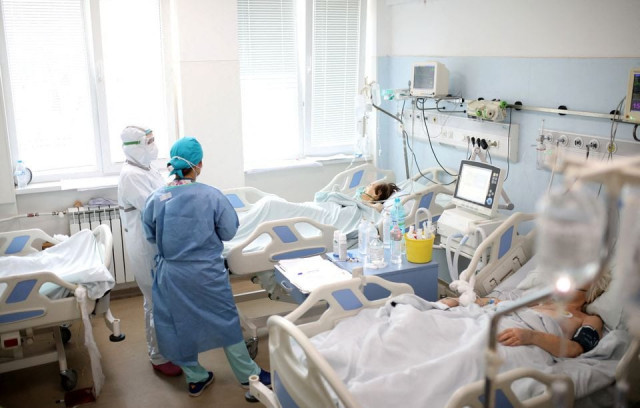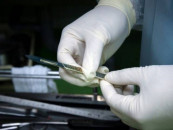Nebulizer shortage plagues public hospitals
Patients with respiratory issues forced to share aerosol masks, receive treatment from private clinics

For asthmatic patients living with breathing difficulties, having quick access to special medications delivered through inhalers and nebulizers is a matter of life and death yet nearly all public hospitals in the port city have failed to guarantee adequate nebulization facilities for the panting adults and ailing infants, who are suffering endlessly with their chronic ailments. Even though seasonal allergies are a universal health concern, affecting all people across the globe to some degree, in Pakistan’s metropolitan hub, Karachi, the proliferation of commercial activity alongside the expansion of industrial zones has elevated the levels of chemical pollutants in the troposphere, which needless to say, has triggered the incidence of various respiratory ailments like asthma among the local population, especially during the inclement weather. However, the repercussions of the sea- sonal epidemic have only been amplified for low-income patients in the city, who in the absence of proper nebulization facilities in public hospital’s either have to take on the risk of sharing contaminated aerosol masks for relief or alternatively turn to costly private care, which has the potentiality of turning their finances upside down.
Read Critical medicines shortage grips K-P
“My doctor at the Abbassi Shaheed Hospital prescribed regular nebulization for treating my chest infection. However, since no nebulizers were available at the hospital, I had to get the treatment done from a private facility, which cost me Rs3000 for just three days,” lamented Asma Shiraz, a resident of Nazimabad, who resents having to bear the additional financial burden. Likewise, Hira, a mother from Liaquatabad, faced a similar predicament when she took her daughter, a pneumonia patient, to the Liaquatabad Hospital for treatment. “Even though nebulizer machines were available at the hospital, we had to wait for several hours due to the long queue. Eventually, my husband decided to take an urgent loan of Rs10,000 so that we could take our daughter to a private clinic for im- mediate medical care,” shared Hira, who further informed that a large influx of patients with asthma, pneumonia and other chest diseases was flowing into the public hospitals, which severely lacked the necessary medical paraphernalia.
According to sources from the Health Department of Sindh and the results of an on-ground survey by The Express Tribune, no nebulization equipment was available across many government hospitals in Karachi, which were receiving a large influx of patients with respiratory complaints, including 20 patients per day at the Sindh Government Ibrahim Hyderi Hospital, 15 patients at the Sindh Government Korangi Hospital, 15 to 20 patients at the Sindh Government New Karachi Hospital, 8 to 10 patients at the Sindh Government Liaquat National Hospital, and an average of 20 to 25 patients per day at the Jinnah and Civil Hospital’s each. The data on the rising number of respiratory patients was confirmed by Amir, a pharmacist, who reported that the demand for nebulizer machines had peaked this winter season, leading to a surge in its price by Rs2000 to Rs5000.
Read Karachi hospitals face serious staff shortage
“While some respiratory medicines have become too expensive, others are entirely out of stock,” revealed Amir. Dr Faisal Asad, Head of the Respiratory Diseases Unit, at the Dow University of Health Sciences, claimed that air pollution, dust, pet fur, household cleaning agents, and kitchen smoke all could contribute towards the rising number of asthma cases. “The symptoms of asthma include shortness of breath, chest tight- ness, wheezing sounds, and persistent cough,” said Dr Asad, who emphasized the importance of timely treatment. Speaking of treatment, sources have also disclosed that in the absence of nebulizers, public hospitals including the Jinnah and Civil Hospitals are directly administering oxygen therapy from a wall point to all patients who are presenting with breathing difficulties, including children.
However, paediatricians, like Dr Khalid Shafi view the unhygienic, stopgap practice with an eye of caution. “Infants with breathing difficulties require a strictly monitored dosage of oxygen, which is determined according to their age and body mass. Over exposure to oxygen can severely damage a baby’s vision,” warned Dr Shafi. On the other hand, Dr Faiza, Head of the Chest Unit at the Sindh Government Hospital, Liaquatabad, highlighted the fact that no special laboratory was avail- able for diagnosing viral illnesses in our hospitals. “A 10 to 20 per cent rise has been observed in cases of respiratory dis- eases due to the flu virus. People must eat a balanced diet, get vaccinated and wear masks for their protection,” she added. Putting his two cents on the situation, Muhammad Tawheed, an urban planner, whilst acknowledging the need for greater facilities in public hospitals, also highlighted the importance of investing in long-term strategies to battle pollution. “We must promote alternative means of transport, ban garbage burning, enforce environmental laws, limit combustion vehicles, and encourage walking and cycling,” he implored


















COMMENTS
Comments are moderated and generally will be posted if they are on-topic and not abusive.
For more information, please see our Comments FAQ